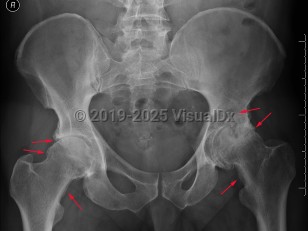Osteoarthritis
Alerts and Notices
Important News & Links
Synopsis
Osteoarthritis is a progressive, degenerative joint disease caused by destruction of joint cartilage and subsequently underlying bone. It is the most common form of arthritis and is thought to be caused by biochemical changes and biomechanical stresses affecting articular cartilage with ongoing use. Common areas of occurrence are the hands, spine, hips, and knees.
Although most patients present with joint pain, stiffness (limited range of motion), tenderness, and lack of flexibility, the age of presentation and temporal progression of disease is variable, driven in part by use / overuse. Joint bones may rub against each other, creating a grating sound, or small bone fragments may form spurs in the joints. Factors affecting deterioration of joint cartilage are older age, obesity, certain occupations, family history, and congenital bone malformations. Associated illnesses are diabetes, gout, and rheumatoid arthritis.
While there is currently no cure for osteoarthritis, there are treatments to reduce pain and increase joint movement. Weight loss, exercise, and other lifestyle changes are the first line of care. Pain-relieving or anti-inflammatory drugs, physical or occupational therapy, patient education, and orthotic or orthopedic supports are forms of conservative management. Corticosteroid injections, surgical procedures, and joint replacement surgery can be helpful in managing pain and maintaining range of motion as the disease progresses.
Although most patients present with joint pain, stiffness (limited range of motion), tenderness, and lack of flexibility, the age of presentation and temporal progression of disease is variable, driven in part by use / overuse. Joint bones may rub against each other, creating a grating sound, or small bone fragments may form spurs in the joints. Factors affecting deterioration of joint cartilage are older age, obesity, certain occupations, family history, and congenital bone malformations. Associated illnesses are diabetes, gout, and rheumatoid arthritis.
While there is currently no cure for osteoarthritis, there are treatments to reduce pain and increase joint movement. Weight loss, exercise, and other lifestyle changes are the first line of care. Pain-relieving or anti-inflammatory drugs, physical or occupational therapy, patient education, and orthotic or orthopedic supports are forms of conservative management. Corticosteroid injections, surgical procedures, and joint replacement surgery can be helpful in managing pain and maintaining range of motion as the disease progresses.
Codes
ICD10CM:
M19.90 – Unspecified osteoarthritis, unspecified site
SNOMEDCT:
396275006 – Osteoarthritis
M19.90 – Unspecified osteoarthritis, unspecified site
SNOMEDCT:
396275006 – Osteoarthritis
Look For
Subscription Required
Diagnostic Pearls
Subscription Required
Differential Diagnosis & Pitfalls

To perform a comparison, select diagnoses from the classic differential
Subscription Required
Best Tests
Subscription Required
Management Pearls
Subscription Required
Therapy
Subscription Required
References
Subscription Required
Last Reviewed:03/29/2018
Last Updated:03/29/2018
Last Updated:03/29/2018
Osteoarthritis

